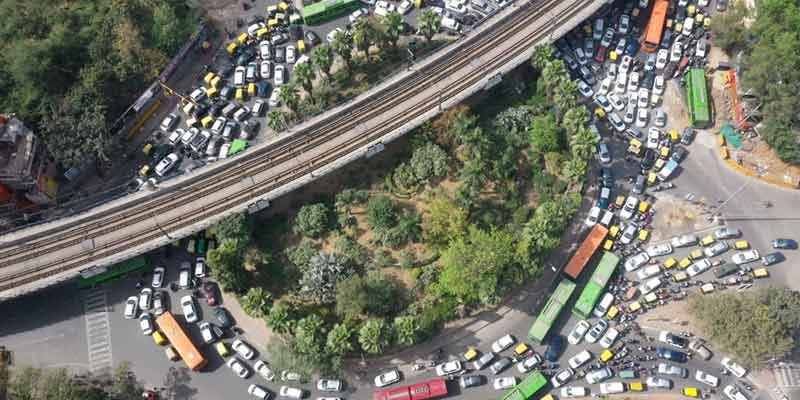- India
- Aug 20
What is transit-oriented development?
• Transit-oriented development (TOD) is densification around nodes and corridors of public transit so that households can live in close proximity to their jobs. It enables them to walk to work or use public transit when required, instead of depending on private vehicles.
• It includes a mix of commercial, residential, office and entertainment centered around or located near a transit station.
• Dense, walkable, mixed-use development near transit attracts people and adds to vibrant, connected communities.
• Many states in India are working on transit-oriented development policies. Also, the ministry of housing and urban affairs has notified the National Transit Oriented Development Policy in May 2017.
Why is it in the news?
• The Asian Development Bank will provide $500 million loan to expand the metro rail network in Bengaluru with the construction of two new metro lines totaling 56 kilometers. The project will construct two new metro lines, mostly elevated, along Outer Ring Road and National Highway 44 between Central Silk Board and Kempegowda International Airport with 30 stations. This will help decongest traffic in the city area and provide seamless connectivity to the airport.
• The project supports the urban transformation of Bengaluru city into a more livable and sustainable city through support to urban public transport and urban development with concepts of transit-oriented development and multi-modal integration (MMI).
• The TOD-based urban development model will target realigning growth and increase the city’s economic productivity by creating higher density, compact, mixed-use, mixed-income, safe, resource-efficient and inclusive neighbourhoods.
• Recently, the Delhi Development Authority had approved modification in the Transit Oriented Policy (TOD) for the city, seeking to unlock the latent economic potential.
Scope of transit-oriented development
• Transit-oriented development (TOD) embraces the idea that locating amenities, jobs, shops and housing around transit hubs promotes transit use and non-motorised travel. Careful planning softens the perception of density and facilitates the emergence of vibrant communities.
• It can be applied to metropolises as well as smaller cities.
Benefits of TOD:
• Concentrating development in the one-kilometer radius around transit stations offers a unique opportunity to shape cities and make them more livable, efficient, and inclusive.
• Transport and housing are traditionally the largest expenditures for households, often accounting for more than half of their income. Inclusive TOD plans for low income and affordable housing near mass transit stations enhance access to job opportunities for all.
• Transit-oriented cities are more competitive than other cities, as a result of agglomeration effects. Doubling job density increases economic productivity by 5–10 per cent.
• TOD increases and concentrates real estate value in the best-connected areas. This concentration offers opportunities to reinvent urban spaces with high-quality public and green areas.
Essentials for TOD:
• High quality public transit network.
• Affordable housing in close proximity to public transit to enable lower income families to access jobs.
• Pedestrian and bicycle infrastructure to ensure access to public transit (last mile connectivity).
• Mix of activities and uses to reduce distances travelled for work or for recreation.
• Urban design that enhances quality of the built and open spaces for all user groups.
Significance of TOD policy in India
• Urbanisation in India has become an important and irreversible process, and it is an important determinant of national economic growth and poverty reduction.
• According to Census 2011, around 37.71 crore Indians (comprising 31.16 per cent) of the country’s population, live in urban areas. As many as 53 cities in India have a million-plus population. At current rate of growth, urban population in India is projected to grow to about 60 crore by 2030.
• Cities and towns have a notable role in India’s socio-economic transformation and change. Apart from their contribution to the country’s gross domestic product (GDP), cities are the center-point of innovations and hub of many activities. At the same time, most cities and towns in India are severely stressed in terms of infrastructure and service availability.
• Land use planning creates a livable environment for balancing the human needs such as housing, working, social interaction, leisure and mobility of persons and goods. Land use planning is important for balancing of competing demands (of human needs) on limited urban space.
• The linkage between land use and transit results in an efficient pattern of development that also help in reducing traffic congestion and urban sprawl.
• TOD policies may perform a crucial role in improving the work to home relation as well as improving the efficiency and sustainability of public transport.
• TOD is widely considered as one of the most sustainable forms of development and is being practiced in many cities across the globe. It reduces the dominance of private motorised vehicle usage and promotes development which is more conducive to transit usage.
Manorama Yearbook app is now available on Google Play Store and iOS App Store




